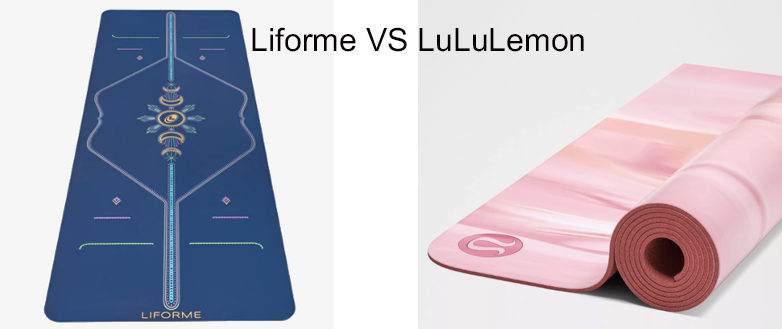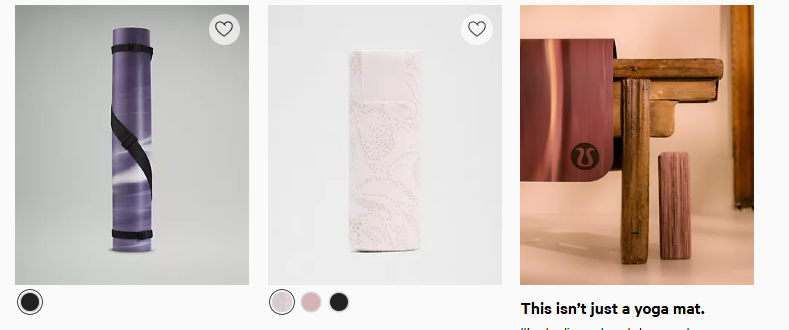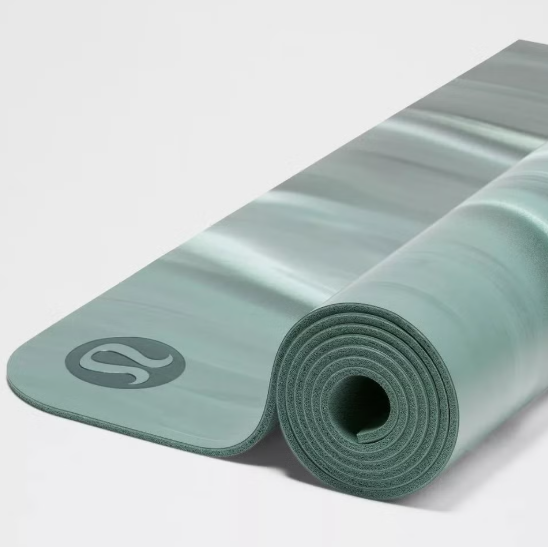Choosing the right yoga mat can make a big difference in your practice. The mat beneath you affects your stability and comfort during poses. This matters for beginners and experienced yogis alike.
In the premium yoga mat market, Liforme and Lululemon stand out. I consider them two of the most popular brands. Both have built strong reputations among yoga fans around the world. But they take different paths in mat design and function.
Liforme is a UK-based brand. I like that they focus on their unique alignment system and eco-friendly materials. The yoga brand has won over yogis who value precision and care about the environment.

Lululemon started as a Canadian athletic clothing company. They now make high-quality yoga mats too. Lululemon uses its knowledge from making activewear. They create mats that mix performance with good looks. This appeals to people who want function and style.
What This Comparison Will Cover
I want to give you a clear comparison between Liforme yoga mats and Lululemon yoga mats. This will help you decide which one offers better value for your money.
A quick comparison of Liforme and Lululemon yoga mats
|
Feature |
Liforme Yoga Mat |
Lululemon Yoga Mat |
|---|---|---|
|
Material |
Natural rubber + eco-polyurethane |
Natural rubber + polyurethane |
|
Grip |
Excellent (dry & wet) |
Very good (slightly less when sweaty) |
|
Thickness |
4.2mm (comfortable cushioning) |
5mm (denser, stable feel) |
|
Weight |
Around 2.5kg |
Around 2.3kg |
|
Design |
Alignment lines, eco design |
Sleek minimalist look |
|
Eco-Friendly |
✅ 100% biodegradable materials |
⚪ Partially eco-friendly |
|
Durability |
★★★★★ |
★★★★☆ |
|
Price Range |
$150 – $170 |
$100 – $120 |
|
Best For |
Serious yogis who value grip & sustainability |
Everyday practice and travel use |
|
Overall Value |
⭐⭐⭐⭐⭐ |
⭐⭐⭐⭐ |
By the end, you’ll know which yoga mat—Liforme or Lululemon—best fits your practice style, budget, and values. I’ll share my insights to help you make the right choice.
Brand Overview
Liforme: Precision-Focused UK Innovation
Liforme launched in the UK with a clear mission. They wanted to create the world’s best yoga mat. The brand entered the market around 2013 after years of research and development.

The company built its reputation on three core pillars:
-
Eco-consciousness – Liforme uses natural rubber and sustainable materials. Their mats are free from PVC and toxic chemicals.
-
Alignment system – They pioneered the “AlignForMe” marking system. This unique feature helps yogis position their hands and feet during practice.
-
Premium positioning – Liforme targets serious practitioners. They focus on yogis who want professional-grade equipment.
The brand has won multiple awards in the wellness industry. Their Liforme Yoga Mat retails between $140-$160. This puts them at the high end of the yoga mat market.
Liforme’s customer base includes yoga teachers, studio owners, and dedicated practitioners. Many appreciate the brand’s commitment to the environment. The company partners with organizations to plant trees. They also work to reduce plastic waste.
Lululemon: Athletic Lifestyle Giant
Lululemon Athletica began in Vancouver, Canada in 1998. Founder Chip Wilson focused on yoga apparel at first. The company expanded into yoga accessories as a natural extension of their brand.

Lululemon’s approach to yoga mats reflects their broader philosophy:
-
Performance-driven design – They use technical knowledge from athletic wear to create mats
-
Style integration – Lululemon mats feature modern aesthetics that match their clothing lines
-
Community building – The brand hosts free yoga classes and events to connect with customers
-
Product variety – They offer multiple mat options at different price points
The Lululemon Reversible Mat is their flagship product. It sells for $78-$88. This makes Lululemon more accessible than Liforme. But they still maintain premium quality.
Lululemon operates hundreds of retail stores around the world. This gives them a distribution advantage. You can touch and test their mats before buying. The brand has built trust with millions of yoga and fitness enthusiasts.
Their market position is broader than Liforme. Lululemon appeals to casual yogis, gym-goers, and fashion-conscious consumers. This wider audience strategy has made them a household name in activewear.
Core Differences
Grip and Surface Texture
Liforme mats have excellent grip. The surface gives you strong traction even when you sweat. I find this vital for hot yoga or fast-paced vinyasa flows.
The grip uses Liforme’s “GripForMe” material. This surface works well dry and wet. Many users say they hold tough poses longer without slipping.
The alignment markings on Liforme mats do two things. They guide your pose positioning. They also create tactile cues you can feel with your hands and feet. I like this if you want physical feedback for proper form.

Lululemon’s Reversible Mat has a smooth, flexible surface. The mat offers solid grip for most practice styles. The polyurethane top layer gives reliable traction.
The grip is steady but less strong than Liforme. Some people prefer this smoother feel. It makes transitions between poses easier. The reversible design gives you two texture options in one mat.
Reviews rate Lululemon mats well for value in the premium mat category. The grip works well for most yoga styles. I recommend it for travel and multi-purpose use.
Key grip differences:
– Liforme offers better wet-grip performance
– Lululemon gives flexible all-around traction
– Liforme includes alignment-focused tactile features
– Lululemon delivers smooth transitions

Related Reading: What Is The Gaiam Yoga Mat Manufacturer
Thickness and Cushioning
Liforme Original measures around 4-4.2 mm thick. This balances cushion and stability. The mat feels firm compared to thicker options.
I like this firmness for alignment-focused yoga styles. The thinner profile keeps you closer to the ground. This boosts your balance and stability during standing poses.
The cushioning still protects your joints well. But it focuses on connection to the floor. This suits people who value precision over softness.
Lululemon Reversible Mat is around 5 mm thick. This gives more cushion than Liforme. The extra millimeter makes a real difference during practice.

The added thickness feels better for longer holds. It protects sensitive joints better. If you practice on hard floors, I suggest this extra cushioning.
The softer feel suits restorative yoga and gentle practices. It also helps people who need extra knee or wrist support.
Thickness comparison:
– Liforme: 4-4.2 mm – firm, stability-focused
– Lululemon: 5 mm – cushioned, comfort-oriented
– Liforme better for balance work and standing poses
– Lululemon better for joint protection and floor work
Price and Value Proposition
Liforme mats sit at the premium price point. The Liforme Yoga Mat retails between $140-$160. This price reflects several factors.
You pay for the alignment marking system. You invest in premium eco-friendly materials. The strong grip technology adds to the cost.
The higher price targets serious practitioners. It appeals to those who view their mat as professional equipment. Many yoga teachers and studio owners choose Liforme despite the cost.
Lululemon mats also sit in the premium tier. The Reversible Mat sells for $78-$88. This makes Lululemon about half the price of Liforme.
Reviews often cite Lululemon as offering strong value for money. The quality matches the price well. You get premium performance without the ultra-premium cost.
Lululemon’s wider retail presence creates more deal opportunities. You might find sales or member discounts. This can make the value even better.
Price comparison breakdown:
– Liforme: $140-$160 (ultra-premium positioning)
– Lululemon: $78-$88 (premium but accessible)
– Price difference: About $60-$80
Value considerations:
I recommend Liforme if you:
– Practice yoga daily or as a professional
– Need alignment guidance for form improvement
– Want maximum grip for hot or sweaty practices
– Value specialized yoga-specific features
I suggest Lululemon if you:
– Want premium quality at moderate cost
– Practice multiple fitness activities beyond yoga
– Prefer flexibility over specialization
– Need a reliable mat without maximum investment
The cost-per-use factor matters a lot. For regular practitioners, both mats justify their price over time. Liforme costs more upfront but targets dedicated users. Lululemon gives excellent durability at a more accessible entry point.
Which is more worth buying?
Your choice between Liforme and Lululemon depends on three things: your practice style, your budget, and what matters most to you in a yoga mat. Both offer premium quality. They just serve different needs. I’ll help you decide based on specific use cases.
Best Choice for Alignment-Focused Practitioners

Liforme wins if you:
-
Need visual and tactile alignment cues during practice
-
Work on improving form and precision in poses
-
Practice Iyengar, Hatha, or alignment-based vinyasa
-
Teach yoga and want to demonstrate proper positioning
-
Value yoga-specific features over versatility
The AlignForMe system sets Liforme apart. No other premium mat offers this level of alignment guidance. I find this feature alone justifies the price for serious practitioners.
Many yoga teachers say their students improve faster with alignment-marked mats. The visual guides help beginners understand proper hand and foot placement. Advanced yogis use the markers to refine their practice.
Price consideration: At $140-$160, you pay for specialized innovation. If alignment matters to your practice goals, I recommend this investment.
Best Choice for Hot Yoga and Sweaty Practices
Liforme is the better option for:
Hot yoga (Bikram, heated vinyasa)
Power yoga sessions
Practitioners who sweat a lot
Classes in humid environments
The GripForMe technology performs well when wet. Reviews praise Liforme’s grip during sweaty practices. I notice the difference in downward dog and warrior poses.
Lululemon works for moderate sweat. But it doesn’t match Liforme’s wet-grip performance. If you practice hot yoga often, the extra $60-$80 for Liforme pays off in safety and confidence.
Best Choice for Multi-Purpose Fitness Use
Lululemon wins if you:
Practice yoga plus other fitness activities
Want one mat for yoga, Pilates, and stretching
Travel often and need a versatile mat
Value smooth transitions between different exercise styles
Prefer flexibility over specialization
The reversible design gives you options. Use one side for yoga. Flip to the other for different grip needs. This works well for people who cross-train.
Price advantage: At $78-$88, Lululemon delivers premium quality at half the cost of Liforme. For multi-sport athletes, this makes financial sense.
Best Choice for Budget-Conscious Yogis
Lululemon offers better value if:
-
You want premium quality without ultra-premium pricing
-
You’re building your home practice setup on a budget
-
You’re new to yoga and testing your commitment level
-
You practice 2-3 times per week
The $60-$80 price difference matters for many practitioners. Lululemon gives you excellent durability and performance. You don’t sacrifice much quality for the lower price.
I suggest starting with Lululemon if you’re unsure about long-term commitment. You can always upgrade to Liforme later if your practice deepens.
Best Choice for Joint Protection and Comfort
Lululemon wins for cushioning needs:
-
5mm thickness vs Liforme’s 4-4.2mm
-
Better for sensitive knees, wrists, or elbows
-
More comfortable for floor work and restorative poses
-
Suits gentle yoga styles and longer holding practices
The extra millimeter makes a real difference during practice. I feel less joint fatigue on thicker mats during long sessions. If you need extra cushioning, Lululemon delivers.
Liforme suits you if: You prioritize stability over cushion. The firmer surface helps with balance work and standing sequences.
Best Choice for Travel and Portability
Lululemon has practical advantages:
-
Available in many retail locations worldwide
-
Easier to replace if lost or damaged while traveling
-
Reversible feature adds versatility in different spaces
-
Good grip-to-weight ratio for carrying
Liforme offers a Travel Mat option at different specs. But the standard Liforme mat is less portable than Lululemon. Consider this if you practice in multiple locations often.
Final Recommendation
I’ve compared Liforme and Lululemon yoga mats. I looked at materials, grip, cushioning, durability, and price. Now I can guide you clearly. Your choice depends on how often you practice, your budget, and what matters most to you in a yoga mat.
Still unsure? Start with Lululemon. The lower price lets you test premium mat quality. You’ll know within 2-3 months if you need Liforme’s specialized features. Many practitioners stay with Lululemon forever.
The best yoga mat is the one you’ll use. Both Liforme and Lululemon will serve you well for years. Choose based on your honest assessment of how you practice—not how you think you should practice.
Your investment in either mat supports your yoga journey. It beats any budget alternative. Make your choice and commit to regular practice. That commitment matters more than the mat beneath you.

